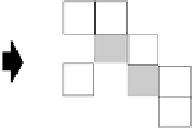Image Processing Reference
In-Depth Information
%
+/
8
#<
=6
Fig. 5.20.
Illustration of Algorithm 5.19 (arc elimination).
This is easily confirmed by noting that any trivial knot longer than
4
obviously includes the part that is reduced by Algorithms 5.19 and 5.20. The
latter half is confirmed easily from Fig. 5.23.
The following is not proved, although it is expected empirically.
Conjecture 5.1.
The minimum length of a knotted knot (nontrivial knot) is
26
and the number of crossing points is
3
.
[Explanation]
As an example, Fig. 5.25 shows a knot of the length
26
and the number
of the crossing points
3
. As far as visual observation is concerned, this cannot
be reduced to a knot shorter than
26
. A link consisting of two trivial knots
requires two trivial knots of the length
12
(Fig. 5.24). By connecting them at
two points, a knot of the number of the crossing points
3
is obtained. But it
cannot be realized by a curve shorter than the length
25
.
Remark 5.22.
Knottedness cannot be detected by features presented in the
previous chapter such as the Euler number and the connectivity index.
5.8 Voronoi division of a digitized image
Voronoi division (Voronoi tessellation) was originally defined for a point set
in continuous space, and has been studied extensively in the field of com-























Search WWH ::

Custom Search